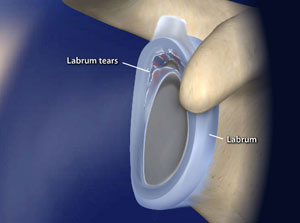Omaha Glenoid Labrum Tears Animation
Omaha Glenoid Labrum Tears
Learn about Glenoid Labrum Tears from Dr. Keiser
 This injury is a tear of the labrum, a thick band of cartilage that lines the rim of the glenoid (which is commonly called the shoulder socket).
This injury is a tear of the labrum, a thick band of cartilage that lines the rim of the glenoid (which is commonly called the shoulder socket).
The labrum cushions the head of the humerus and holds it securely to the glenoid, stabilizing the joint.
The labrum acts as a bumper to help keep the ball in the socket. This animation describes labral tears in general. Labral tears can occur in different locations around the shoulder socket.
A labral tear at the top of the socket is called a SLAP tear. The animation on SLAP tear can help explain this type of labral tear further. A labral tear can also occur to the back part of the socket.
A labral tear that occurs in the lower portion of the front of the socket is called a bankart tear. This type of tear is explained further in the procedure animation video labeled bankart repair.
Diagnosis of Glenoid Labrum Tears
Learn about Diagnosis of Glenoid Labrum Tears
Advances in medical technology are enabling doctors to identify and treat injuries that went unnoticed 20 years ago. For example, physicians can now use miniaturized television cameras to see inside a joint. With this tool, they have been able to identify and treat a shoulder injury called a glenoid labrum tear.
If you are experiencing shoulder pain, your doctor will take a history of your injury. You may be able to remember a specific incident or you may note that the pain gradually increased. The doctor will do several physical tests to check range of motion, stability, and pain. In addition, the doctor will request x-rays to see if there are any other reasons for your problems.
Because the rim of the shoulder socket is soft tissue, x-rays will not show damage to it. The doctor may order a computed tomography (CT) scan or magnetic resonance imaging (MRI) scan. In both instances, a contrast medium may be injected to help detect tears. Ultimately, however, the diagnosis will be made with arthroscopic surgery.
Tears can be located either above (superior) or below (inferior) the middle of the glenoid socket. A SLAP lesion (superior labrum, anterior [front] to posterior [back]) is a tear of the rim above the middle of the socket that may also involve the biceps tendon.
A tear of the rim below the middle of the glenoid socket that also involves the inferior glenohumeral ligament is called a Bankart lesion.
Tears of the glenoid rim often occur with other shoulder injuries, such as a dislocated shoulder (full or partial dislocation).
Treatment of Glenoid Labrum Tears
Learn about the treatment of Glenoid Labrum Tears
Until the final diagnosis is made, your physician may prescribe anti-inflammatory medication and rest to relieve symptoms. Rehabilitation exercises to strengthen the rotator cuff muscles may also be recommended. If these conservative measures are insufficient, your physician may recommend arthroscopic surgery.
During arthroscopic surgery, the doctor will examine the rim and the biceps tendon. If the injury is confined to the rim itself, without involving the tendon, the shoulder is still stable. The surgeon will remove the torn flap and correct any other associated problems. If the tear extends into the biceps tendon or if the tendon is detached, the shoulder is unstable. The surgeon will need to repair and reattach the tendon using absorbable tacks, wires, or sutures.
Tears below the middle of the socket are also associated with shoulder instability. The surgeon will reattach the ligament and tighten the shoulder socket by folding over and “pleating” the tissues.
Click on shoulder conditions to learn more!
Omaha shoulder information provided by Darren Keiser
